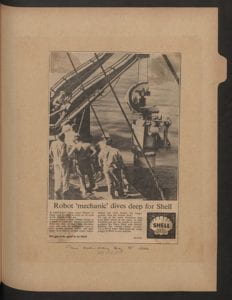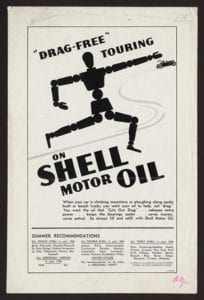
Marvin the Mobot and Shell: robotics history and oil exploration
Ary Hermawan
One of the most fascinating historical documents in the Shell Historical Collection stored at the University of Melbourne Archives is a press cutting of an advertisement placed in the Sun newspaper on Monday, August 19th, 1963. The ad features a photograph of a group of workers lowering the company’s Mobot — an underwater maintenance robot that can see with its “television eyes” and uses “its mechanical nose to turn screws and operate valves and grip pipes as it moves around under water.” Being lowered to the sea from a ship, the Mobot appears to be made to show the company’s technological prowess, with the robot being portrayed as “one of the many inventions that keep Shell ahead of the times.”

While two other advertisements in the collection feature the cartoon of a 3-CPO-style android moving clumsily while carrying motor oils, this image is the only one featuring a non-fictional robot.


The advertisement however provides little information about the image, which only serves as an illustration to the advertorial that accompanies it. A Google search of the word “Mobot”, however, leads to several web pages providing important background to what may be the first published image depicting the deployment of this unique marine robot. A collection of newspaper and magazine articles uploaded by robotics enthusiast Reuben Hogget on his blog cyberneticzoo.com indicate that the image used in the Shell advertisement was taken at Port Hueneme, California, the United States, in October 1962. “It was the first public showing for the mechanical roustabout,” according to an unidentified press release uploaded by Hogget. It was not only a landmark event for Shell but also the field of robotics and deep-sea exploration, with the United Nations calling it “the first achievement” in the history of underwater robots. It is no surprise that its launch drew a considerable amount of press coverage.
An article published in Science and Mechanics in August 1963 describes the Mobot as a “mechanical giant” that “is at home in the sea”, contrasting it to the many robots of its days that were designed primarily to explore the outer space. Mobot, the article says, “is knocking on the door beyond which lies the world of the secretive sea.” Developed by Shell in collaboration with the Hughes Aircraft Company the robot was intended to do dangerous underwater operations that human divers cannot do, at least effectively. And, as Dr. J. W. Clark of Hughes Aircraft said, the Mobot opened up the use of deep-sea robots for various purposes, ranging from underwater mining, farming to salvage operations.
But the history of technology and capitalism is often problematic.
The Science and Mechanic article portrays the Mobot as a technology in the Heideggerian sense—techne as an extension of human capabilities, but also as aleitheia, a mode of revealing. The technology of robotics, in so many ways, represents our desire to uncover the secrets of the unknown, in this instance, the deep sea where perhaps hidden ‘shells’ may be found. Such scientific curiosity was however primarily driven by capitalist modes of production that foster extractive industries, such as oil, at the expense of the marine environment. Soon after the Mobot was operated concerns were raised over whether the machine could harm divers and marine creatures: would the Mobot prove to be “a friend or a foe”, even though its operators were quick to call it “Marvin” or a “friend of the sea”.
But as concerns grow over global heating, which is to blame for the recent hydrological disasters in many parts of the world, many have called for a rethink in how we do business today, particularly in the mining sectors in which technologies like Mobot have played an important role. The Mobot advertisement in the Sun newspaper 58 years ago may spark our imagination about the importance of robotic technology in “a brave new world”. But far from mere curiosity, the story of Mavrin and Shell may make us ponder, what else there is to such partnerships? The historical document may now also reflect the mistakes we have made as we pay the price of using technology to exploit the oceans for the sake of feeding our own greed for oil.
Ary Hernawan is a PhD candidate in the Asia Institute. Examining the legal archives of online defamation cases, his PhD research examines the formation/evolution of digital information control strategies in Indonesia since the downfall of Soeharto.
Leave a Reply